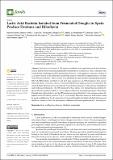Por favor, use este identificador para citar o enlazar a este item:
http://hdl.handle.net/10261/249920COMPARTIR / EXPORTAR:
 SHARE SHARE
 CORE
BASE CORE
BASE
|
|
| Visualizar otros formatos: MARC | Dublin Core | RDF | ORE | MODS | METS | DIDL | DATACITE | |

| Título: | Lactic acid bacteria isolated from fermented doughs in Spain produce dextrans and riboflavin |
Autor: | Llamas-Arriba, Maria Goretti; Hernández-Alcántara, Annel M. CSIC ORCID ; Mohedano Bonillo, Mari Luz CSIC ORCID ; Chiva, Rosa Ana CSIC ORCID CVN; Celador Lera, Lorena; Velázquez Pérez, Encarna CSIC ORCID; Prieto Orzanco, Alicia CSIC ORCID ; Dueñas, María Teresa; Tamame, Mercedes CSIC ORCID CVN; López García, Paloma CSIC ORCID | Palabras clave: | Lactic acid bacteria Dextrans Riboblavin Sourdoughs |
Fecha de publicación: | 2021 | Editor: | Multidisciplinary Digital Publishing Institute | Citación: | Foods 10(9): 2004 (2021) | Resumen: | Many lactic acid bacteria (LAB) produce metabolites with applications in the food industry, such as dextran-type exopolysaccharides (EPS) and riboflavin (vitamin B2). Here, 72 bacteria were isolated from sourdoughs made by Spanish bread-makers. In the presence of sucrose, colonies of 22 isolates showed a ropy phenotype, and NMR analysis of their EPS supported that 21 of them were dextran producers. These isolates were identified by their random amplified polymorphic DNA (RAPD) patterns and their rrs and pheS gene sequences as LAB belonging to four species (Weissella cibaria, Leuconostoc citreum, Leuconostoc falkenbergense and Leuconostoc mesenteroides). Six selected strains from the Leuconostoc (3) and Weissella (3) genera grew in the absence of riboflavin and synthesized vitamin B2. The EPS produced by these strains were characterized as dextrans by physicochemical analysis, and the L. citreum polymer showed an unusually high degree of branching. Quantification of the riboflavin and the EPS productions showed that the W. cibaria strains produce the highest levels (585–685 μg/and 6.5–7.4 g/L, respectively). Therefore, these new LAB strains would be good candidates for the development of fermented foods bio-fortified with both dextrans and riboflavin. Moreover, this is the first report of riboflavin and dextran production by L. falkenbergense | Descripción: | 20 páginas, 8 figuras, 3 tablas | Versión del editor: | http://dx.doi.org/10.3390/foods10092004 | URI: | http://hdl.handle.net/10261/249920 | DOI: | 0.3390/foods10092004 | E-ISSN: | 2304-8158 |
| Aparece en las colecciones: | (IRNASA) Artículos (IBFG) Artículos |
Ficheros en este ítem:
| Fichero | Descripción | Tamaño | Formato | |
|---|---|---|---|---|
| Lactic acid bacteria isolated from fermented doughs in Spain produce dextrans and riboflavin.pdf | Artículo principal | 20,84 MB | Adobe PDF |  Visualizar/Abrir |
CORE Recommender
Page view(s)
118
checked on 24-abr-2024
Download(s)
150
checked on 24-abr-2024
Google ScholarTM
Check
Altmetric
Altmetric
Este item está licenciado bajo una Licencia Creative Commons

